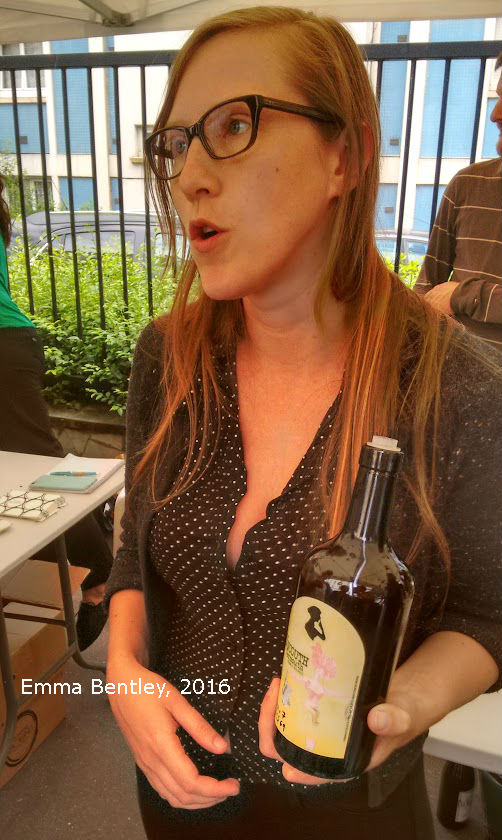The short answer – but that doesn’t mean that you should stop reading – is:
Vermouth is a fortified, aromatised wine.
Essentially, you take a neutral wine (historically, a poorly made, probably oxidised, local wine), give it some flavour and then stabilize your concoction by adding brandy (or some similar distilled spirit.)
The hallmark botanical for vermouth is artemisia, otherwise known as the mystical herb, wormwood.
Wormwood in English -> Wermut in German -> Vermouth in French.
Wormwood is far from being the only botanical used. Each producer will have their preferred combination of herbs (mint and other medicinal plants), roots (ginger, burdock), barks (cinnamon), spices (cloves, cardamom, nutmeg, star anise), fruit (juniper berry, citrus peel), flowers (rose petal, camomile)…
They will each have their own method for infusing or macerating their different ingredients in the wine or the brandy.
Speaking of different methods, there are two main styles of vermouth: Italian and French.
Italians traditionally made sweet, red vermouth whereas the French tended towards a dry, white version.
The Italian tradition started in Turin (Piedmont) in the 18th century, when vermouth was being drunk straight for its supposed medicinal properties. However, a hundred years later, it was being mixed into cocktails.
Nowadays, you’ll mainly see vermouth used in cocktails. It’s an essential ingredient in classics such as the dirty martini, negroni and manhattan.
You also find other styles of vermouth – e.g. extra-dry white, sweet white, amber and rosé – which are nothing more than a marketing ploy under the disguise of special or exclusive bottlings
Even if you’re not entirely sure you know what vermouth is, you have almost certainly seen the main mass-market brand: Martini & Rossi. Before I had any interest in booze, (I’m still rather embarrassed about this stage of my life!) I used to drink “Martini and lemonade” at the school disco. It would cost 80p.
Unsurprisingly, given the recent gin trend – (you like gin?) – there has been an increase in small-batch vermouth.
Contratto, one of Italy’s most historic but lesser known vermouth brands, has been revived by the arrival of Giorgio Rivetti (also of La Spinetta.) They have taken the old, forgotten recipes and are making a range of vermouth, bitters and americano. Very interesting stuff. More to come on them soon.
However, the anti-establishment vermouth movement is expanding beyond just France and Italy.
I met Bianca Miraglia, the founder of artisanal brand Uncouth Vermouth, this past weekend.
 Her vermouths are the bottled equivalent of sticking a middle finger up at an industry dominated by giants – I’m looking at you, Bacardi.
Her vermouths are the bottled equivalent of sticking a middle finger up at an industry dominated by giants – I’m looking at you, Bacardi.
Bianca makes small-batch vermouth. They are hand-made in Brooklyn from foraged herbs, local ingredients and a base wine and brandy from upstate New York. Because wormwood is still forbidden in the US, she uses mugwort, wormwood’s cousin, because she finds it growing wild. She doesn’t add any sugar or caramel (which typically gives red vermouth its colour); she opts for making her red vermouth with beetroot instead.
Interestingly, she hopes to see vermouth regain its historical position as an straight-up apéritif, to be appreciated on the rocks. Her interesting flavour combinations – pear and ginger, apple and mint, dry hops – certainly deserve to be savoured and sipped straight, but only time will tell if this artisanal vermouth movement will take shape.
Further Reading for geeks:
An in-depth look at the history of vermouth on Vermouth 101.
Camper English visited the Noilly Prat vermoutherie in Marseille, France.
The difference between Original Dry and Extra Dry vermouth, also on the Alcademics.
N.B. Dolin has been made near Chambéry (in Savoie, near the Swiss border) since 1821 and was awarded the only French AOC (Protected Designation of Origin) for vermouth in 1932. The Chambéry style is lighter than other French vermouths but unfortunately Dolin is the last remaining producer of Vermouth de Chambéry.
The red style of vermouth found in Turin is often referred to as a Vermouth di Torino. In European law, you’ll find a DOC of that same name, but confusingly, it is no longer enforced. Seek out Cocchi vermouths for the closest modern resemblance.


